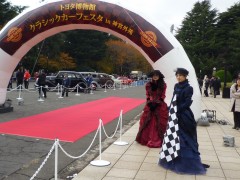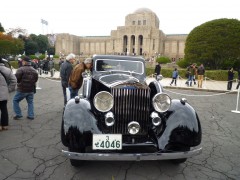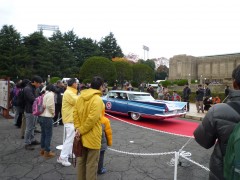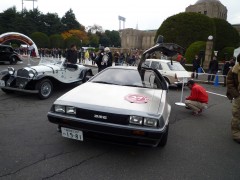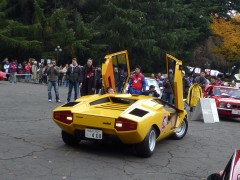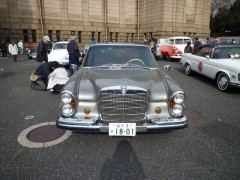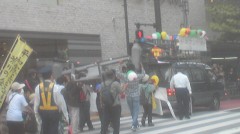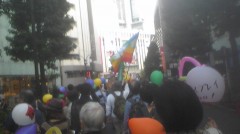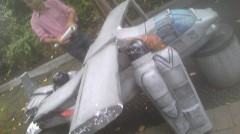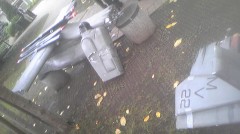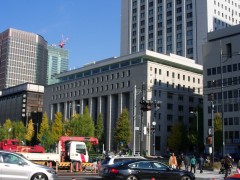03 December 2012
"Classic Car Festa" in Jingu Gaien, Tokyo
It might sound Japanese English. It means Retroprospective automobile exhibition. Tens of the old generation cars lined up in one place, called Jingu Gaien on 1 of December 2012.
It was a great show. I could see a lot of kinds of cars in the old days.
Most notable ones I want to introduce, which I've taken photos of are as follows.
Rolls-Royce
Buick, the length of the body is 5 metre.
De Lorean, Car featured in the film "Back to the Future"
Countach, A car that a driver needs to get his head out of his car when driving back
Mercedes-Benz in 1970's, this was the model when the same titled song was popular.
"Oh, Lord. Won't you buy me a Mercedes Benz?" Are you rich enough to afford those cars?
23:34 Posted in Japan News, Leisure, Tokyo Life | Permalink | Comments (0) | Tags: cars, history
08 October 2012
Japan's protest against Osprey (MV-22) deployment
Joined demonstration march in Shibuya, most crowded shopping and entertaining district in Tokyo.
Estimated around 400 people participated. 12 ospreys were deployed in Okinawa, Southernmost island of Japan. Osprey is a hyprid helicoptor that cause strong noize and probability of accident is higher than conventional helicoptors. Propellers work as helicoptor on pad but when it goes high, the mode is changed to airplane that enables it fly further.
But this mode change action can cause severe accident including crashes onto the ground without control.
It is said that US military deployed Ospreys in Okinawa because they were not allowed to maneuver flying in their homeland because of safety problems, that aggrevated Okinawans and Japanese nationals. US-Japan treaty is one between independent sovereign nations.
As other issues such as Nuclear aircraft carrier (CVN 73) in Yokosuka, safety may not be prioritized issue. Highest prioritized issue is why we have to carry burden of US military which does not actually defend us. Threat from China? China is no longer enemy for the U.S. China has become even more important economic ally than Japan for the U.S. Even US influential congressman said military stationed in Okinawa is nothing but ruin of the Cold War.
Recently even after deployment of the new helicoptors, Chinese ships has invaded Japanese sea near Okinawa very frequently. If deterrence works, why do Chinese do that?
We really wonder why US military is stationed in our country.
We should stop treating America as friendly nation although it is not our enemy.
20:53 Posted in Japan News, Politics, Tokyo Life, US-Japan relationship, USA issues | Permalink | Comments (0) | Tags: military, okinawa, nuclear aircraft carrier, osprey
21 May 2012
Solar Eclipse seen in Tokyo
In the morning of May 21, Monday in Tokyo, from the balcony of my place, I saw beautiful solar eclipse. Of course I used sun glasses dedicated for this event.
I did enjoy it. Once solar shading started, the whole view from the balcony got darker and the temperature got colder.
After a few minutes, the sun became like golden ring from what I saw through the glasses.
Thank you, God. It was in fact the most beautiful show I saw in my life.
This show was actually seen not only in Japan but other parts of the world, California and Northern Texas.
The map and timetable is as follows.
http://latimesblogs.latimes.com/lanow/2012/05/solar-eclip...
|
Location |
Start Partial Eclipse |
Start Annular Eclipse |
Max Eclipse |
End Annular Eclipse |
End Partial Eclipse |
% of sun diameter covered |
|
Hong Kong (AM) |
5:08 |
6:06 |
6:08 |
6:10 |
7:16 |
94% |
|
Taipei (AM) |
5:07 |
6:10 |
6:10 |
6:11 |
7:23 |
94% |
|
Tokyo (AM) |
6:19 |
7:32 |
7:34 |
7:37 |
9:02 |
97% |
|
Crescent City, CA (PM) |
5:07 |
6:23 |
6:26 |
6:28 |
7:35 |
97% |
|
Albuquerque, N.M. |
6:29 |
7:33 |
7:35 |
7:38 |
8:36 |
97% |
|
Redding, CA |
5:11 |
6:26 |
6:28 |
6:30 |
7:36 |
96% |
|
Zion National Park |
6:23 |
7:31 |
7:34 |
7:36 |
8:37 |
96% |
|
Lubbock, Texas |
7:31 |
8:33 |
8:36 |
8:38 |
9:34 |
96% |
|
Lake Tahoe |
5:15 |
6:29 |
6:31 |
6:32 |
7:37 |
95% |
|
Chico |
5:13 |
6:28 |
6:30 |
6:31 |
7:37 |
95% |
|
Eureka |
5:09 |
6:25 |
6:27 |
6:29 |
7:36 |
95% |
|
Grand Canyon |
5:25 |
6:33 |
6:35 |
6:37 |
7:38 |
94% |
|
Yosemite Village |
5:18 |
|
6:33 |
|
7:39 |
92% |
|
Sacramento |
5:15 |
|
6:31 |
|
7:38 |
92% |
|
Las Vegas |
5:23 |
|
6:35 |
|
7:39 |
92% |
|
San Francisco |
5:15 |
|
6:32 |
|
7:39 |
90% |
|
Monterey |
5:18 |
|
6:34 |
|
7:41 |
88% |
|
Palm Springs |
5:26 |
|
6:38 |
|
7:42 |
86% |
|
Lancaster |
5:24 |
|
6:37 |
|
7:42 |
86% |
|
Downtown L.A. |
5:24 |
|
6:38 |
|
7:42 |
85% |
|
Malibu |
5:24 |
|
6:38 |
|
7:42 |
85% |
|
Griffith Observatory |
5:24 |
|
6:38 |
|
7:42 |
85% |
|
Burbank |
5:24 |
|
6:38 |
|
7:42 |
85% |
|
Woodland Hills |
5:24 |
|
6:38 |
|
7:42 |
85% |
|
Chatsworth |
5:24 |
|
6:37 |
|
7:42 |
85% |
|
Santa Monica |
5:24 |
|
6:38 |
|
7:42 |
85% |
|
Alhambra |
5:24 |
|
6:38 |
|
7:42 |
85% |
|
Arcadia |
5:24 |
|
6:38 |
|
7:42 |
85% |
|
Rowland Heights |
5:25 |
|
6:38 |
|
7:42 |
85% |
|
Ontario |
5:25 |
|
6:38 |
|
7:42 |
85% |
|
Anaheim |
5:25 |
|
6:38 |
|
7:42 |
85% |
|
Oxnard |
5:25 |
|
6:38 |
|
7:42 |
85% |
|
Long Beach |
5:25 |
|
6:38 |
|
7:42 |
84% |
|
Redondo Beach |
5:25 |
|
6:38 |
|
7:42 |
84% |
|
Palos Verdes |
5:25 |
|
6:38 |
|
7:42 |
84% |
|
Huntington Beach |
5:25 |
|
6:38 |
|
7:42 |
84% |
|
San Diego |
5:27 |
|
6:39 |
|
7:43 |
83% |
In fact, 18 years ago, when I was a college student in California, I tried to see it but it was a cloudy day so I couldn't see it.
Interesting thing is Japan has a legend of Sun Goddess. Japan is a nation of the Sun Goddess. That means I saw it in the nation of the Sun.
22:03 Posted in Japan News, Science, Tokyo Life | Permalink | Comments (0) | Tags: sun eclipse
07 December 2011
Book on US Occupation of Japan after WW2 "Washington Heights"
A book "Washington Heights" is written by a female journalist, AKIO Satoko. She studied how the United States government managed occupied Japan after the country defeated his enemy. Then she spotlighted on "Washington Heights," which was exclusive residential area for the U.S. military personnels located in the center of Tokyo. The area was built after the war was over by the order of U.S. occupational force. Before the war, it was Japanese imperial army's property. It was located next to Meiji Jingu Shrine, memorial shrine for the Meiji Emperor (crowned between 1868-1912) .
After the Olympic the place turned to famous public park, Yoyogi Park and Japan's public broadcasting station, NHK building.
The book mainly described episodes of Japan's Occupied era (1945-1952) and economic booming era until Tokyo Olympic in 1964. When the U.S. force arrived in Japan, they occupied many places in Tokyo for its administration purpose. The General Head Quarter was placed in Dai-ichi Life Insurance Building near the Imperial Palace.
But they needed housing for soldiers and staff working for the G.H.Q. So they ordered the Japanese government to build housing block for Americans, requiring facilities and equipment equivalent to American standard of that time. That was the hell of a big job for the Japanese government because the places were all burnt down, and shortage of goods.
The Washington Heights, American style housing provided Japanese new culture and lifestyle. Because American personnels and their family living there wanted entertainment, many Japanese entertainers were recruited for performances for them. That caused a big entertainment icon, Journey's Production, which has released many great talents to Japan's showbiz until now. Morie Hana, a famous Japanese fashion designer opened clothing shop for women living in the residential area. She studied most sophisticated western clothing during that time. As for food culture, Japanese learnt fresh vegetable farming to meet demands from Americans. Japanese learnt how to farm vegetable for the fresh salad taking sanitation into account.
As for how Americans thought about occupying Japan was described as well.
When Americans first arrived in Japan after the war, they were surprised because their former enemy citizens were so friendly to them. Many Japanese in fact, felt liberated when the war was over. So occupation worked more smoothly than expected. The U.S. occupation in fact provided democratization of Japan including women's suffrage, reform of biased wealth distribution towards elite class. The U.S. aim was to demilitalize Japan so they thought cracking down feudal customs and elite class power was best way to do.
The U.S. at that time were so worried about communist threat from Soviet Union. So they treated Japan nicely although Japan was a former enemy.
Most interesting episode noted in the book was that a former Japanese military officer met Afro-American man working as lower rank staff of G.H.Q. who told him that Blacks were glad when Japan attacked Pearl Harbor.
The conclusion of the book was U.S. occupation provided Japan great things but we have to remember Japan has been controlled by U.S. since that time and even after Japan recovered independence, we are always facing indirect occupation by the U.S. such as military bases in Okinawa, Tokyo, and diplomatic pressure to liberalize trade and commerce.
Recently the U.S. hegemony has been on the edge as you see "Lehman Shock" and "Occupy Wall Street" movement. The U.S. can no longer function as a role model for Japanese.
Thanks to the U.S. we could have developed the nation acquiring many great things from them but it is time we develop us ourselves in our own way.
22:01 Posted in Books, Culture, Tokyo Life, US-Japan relationship, USA issues | Permalink | Comments (0) | Tags: history, military






